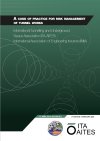A code of practice for risk management in tunnel works
This Code of Practice is the latest edition of a Code prepared jointly by the insurance and
tunnelling industries aimed at reducing the frequency and severity of serious incidents
(resulting in insurance claims) to within sustainable boundaries.
This 3rd Edition follows an industry-wide survey that canvassed opinions on the
application of the Code to date and any necessary updates. The main areas of
revision include adding a list of the principal attributes expected in the Code, addressing
competence and culture, differentiating between risk management and management
of risk, a new section on digital modelling, improved language on both instrumentation
and monitoring and emergency response plans, and clarification of the importance of
managing high consequence events.
The Code sets out industry best practice for the management of construction risks
in underground works which, if followed, should reduce the risk of significant losses
(insured and uninsured) across the industry. The Code has been in use since 2003 and
its widespread adoption has succeeded in reducing incidents and losses to tolerable
levels.
The tunnelling industry is committed to high quality risk management as an enabler of
successful project delivery, and the Code represents a robust framework on which
projects can be modelled.
The Insurance industry uses the Code as a benchmark against which projects can be
assessed. Insurers may require compliance with the Code as a pre-requisite for their
provision of insurance cover for damage to the works during construction.
The Code is intended to apply to all project participants insured via a Construction All
Risks (or similar) policy and is recommended reading for any other party involved in
the planning, design, procurement, and construction of underground works. It
assumes that the reader has a working understanding of the terms defined in Appendix A.
Construction All Risks Insurance policies generally provide cover to all the project
participants from Client to Sub-contractor, and the Code is written to reflect the
responsibilities of each of the participants. Appendix B lists the deliverables
that are expected to be produced at each project stage and will therefore
assist in benchmarking against and/or demonstrating compliance with the Code.
The words shall and should are used to indicate actions that are either required
for compliance, or recommended best practice, respectively. It is recognised,
however, that all projects are unique and may have alternative means of achieving
the overriding principles expected in the Code. Section 1 lists the principal attributes
expected of a project adhering to these best practice principles.
The document is termed as a “Code of Practice”, or “Code” and is intended
to describe best practice or guidance – it is not, in itself, a legal or legally
binding document. It may, however, be contractually binding if referred to as such
in, for example, a construction contract or an insurance policy.
The Code is published jointly by the International Tunnelling and Underground
Space Association (ITA) and the International Association of Engineering Insurers (IMIA).
Bill Grose and Patrick Bravery
January 2023
We would like to thank the following individuals, who generously gave their time and expertise to this revision of the Code:
(Working Group)
Patrick Bravery (co-chair)
Bill Grose (co-chair)
Jim Benson
Robert Goodfellow
Bill Newns
Malcolm Peart
Ozlem Tumer
Eugenio Zoppis
